skip to main |
skip to sidebar
On Saturday, 28th July 2018, I travelled to Hereford by rail to attend the 2018 'Lionsmeet' being held at Hereford Society of Model Engineers.
Wolverhampton-Hereford
I took a taxi to Wolverhampton (our bus service starts too late on a Saturday to be of help), a 'Virgin' London working to Birmingham New Street and then a 'West Midland Trains' service was supposed to take me to Hereford. The taxi worked, the short leg to Birmingham worked but the final segment proved 'interesting'.
I found the Class 172 Diesel Multiple Unit (DMU) which was to form the 08:50 to Hereford in platform 10. The unit was shut down and displaying a red tail lamp at each end but the Conductor had already arrived, opened the doors and passengers were boarding.
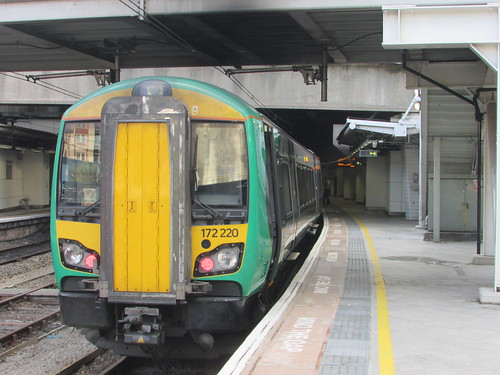
West Midland Railways: Birmingham New Street: Class 172 in platform 10, 28th July 2018.
The driver appeared, started the unit and we departed on time. The train slowly left New Street on the Down Gloucester line, passing through four tunnels (Holliday Street, Canal, Granville Street and Bath Row) before speed increased through Five Ways Station. We were due to stop at University Station, about two and a half miles from our starting point but suddenly the driver made a 'Full Service' brake application and we came to a rapid stop. 'What now?' I thought. I was sitting on the left (as I usually do, offering a limited view of passing signals) and could see no reason for our unscheduled halt. On the right of the train, clouds of smoke drifted by and passengers on that side started to take pictures with their mobile phones. Still puzzled, I got up, moved across and looked ahead on the right. I was quite started to see fierce flames on the heavily overgrown embankment.
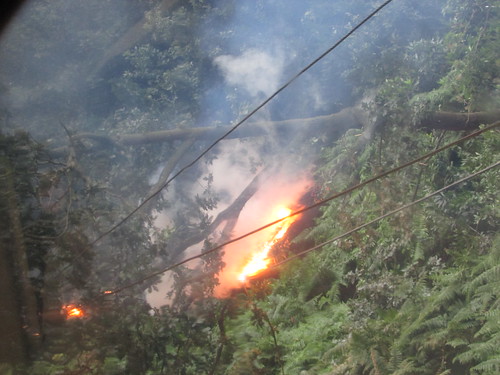
28th July 2018: Near University, a fallen tree on the embankment on the Up side had displaced the wires of the overhead traction system, producing a fairly spectacular fire.
The view from modern trains is not good and looking obliquely ahead through the double-glazed window unit was not ideal but it appeared that a tall tree on the embankment had fallen across the tracks and the return conductor, catenary wire and contact wire had all been pushed towards the ground by the weight of the tree. The main trunk was now horizontal, balanced across the overhead lines. The orange flames appeared to be the dry undergrowth burning but there was also a bright, white light in the fire suggesting that sustained arcing from the overhead system might still be occurring. As I watched the impressive display, there was a loud 'Whump', startling a number of passengers, and the white light ceased. I imagined this might be as the traction system finally 'tripped', or was intentionally discharged following a call on the radio from our driver. The orange flames continued and the young conductor announced that we were setting back a few yards to maintain a safe distance from the conflagration. The driver 'changed ends' and moved the train fifty yards or so back towards Birmingham New Street.
As we waited, I was impressed that, rather than resorting to the public address, the conductor worked his way through the 2-coach train advising passengers directly of his rather gloomy prediction that "we could be stuck here for hours". That seemed unduly pessimistic to me (we were only about two miles from Birmingham New Street Station) and, indeed, after perhaps ten minutes the conductor announced that we were returning to New Street. The driver set off 'wrong road' back the way we'd come but after a few hundred yards, an emergency crossover crossed us to the 'right road' and we continued under normal signalling back to New Street Station. We were were routed back into platform 10, where the colour light signal halfway along the platform beckoned us to the stop at the south end of the platform face. Birmingham New Street retains much of its complex network of approach routes, offering alternative ways of keeping trains moving when a line become unavailable. I anticipated that we'd continue our journey by taking the Up Derby as far as Grand Junction, diverging to St. Andrews Junction and then taking the Camp Hill line so as to regain our original route at Kings Norton. The Camp Hill line is not electrified, so that option was not available to the 'Cross City' service of Electrical Multiple Units (EMU) which provide a frequent commuter service to Longbridge and Redditch.

'Environs of Birmingham & Wolverhampton' from the 11th Edition of the Pre-Grouping 'Railway Map of England and Wales' published by W & A K Johnston.
Passengers who wanted stations to Kings Norton were advised to disembark and new passengers boarded. It was almost an hour since our initial departure so the new passengers had probably arrived for the next service. Still anxious not to give false hope to his passengers, the conductor announced that "at some point" our train would depart. Almost immediately, the signal cleared and the conductor ran to the 'back cab' to get the train away. As expected, we were routed to the Camp Hill line.
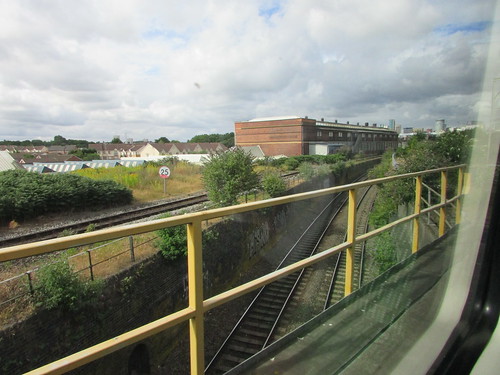
Flyunder near Grand Junction, Birmingham. L-R: Down Camp Hill, Down Derby, Up Derby, Up Camp Hill (on bridge), 28th July 2018.
At Kings Norton, we were back on the electrified route and each station we passed had an EMU waiting in the Up platform, unable to proceed further towards Birmingham until the catenary damage near University Station had been addressed.
I'd not been following the saga of the extension of electrification from Barnt Green (where the single-line branch to Redditch diverges), down the famous Lickey Incline to a new enlarged, remodelled and resignalled station at Bromsgrove. This was to have been completed in 2014 and the new 4-platform station certainly looked impressive. I discovered afterwards that the new, improved electric services were to start the very next day - Sunday 29th July 2018 - a mere four years late!
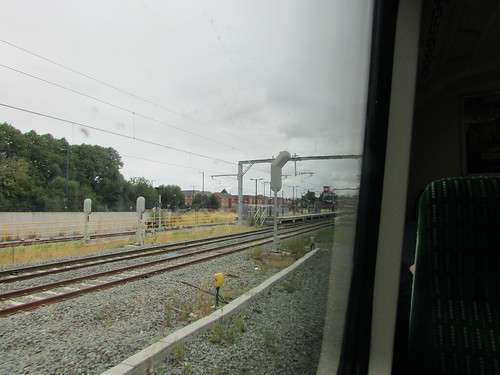
South end of the remodelled Bromsgrove station: 28th July 2018:
Two miles beyond Bromsgrove, we diverged right at Stoke Works Junction and, after four miles of single track, joined the double-track line from Kidderminster at Droitwich Spa Junction. Lower quadrant signals and a standard GWR design signal box (albeit with modern alterations) confirmed that we were now on former Great Western lines.
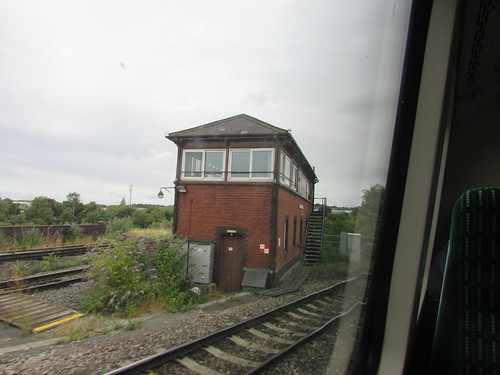
Worcester Area Rail: Droitwich Spa signal box 28th July 2018
As we continued our journey, the conductor announced that his Control had informed him that our late-running service would now terminate at Great Malvern and that passengers for stations beyond there should de-train at Worcester Foregate Street where road transport onwards would be made available. On our modern railway system (which a member of the Rail Delivery Group recently had the temerity to describe as "the envy of Europe") passengers, who are now called 'customers', are casually treated with contempt. Although the original reason for delay was unfortunate (although probably avoidable with better arrangements for periodic lineside inspection and maintenance), Control's concern was to seek to get the unit and crew back onto their scheduled 'diagram', by turning the train around short of its destination. The inconvenience to passengers didn't seem to feature in their calculations, as we discovered on our arrival at Worcester Foregate Street where station staff confirmed that there was no onwards road transport and we should simply wait for a following train to Hereford.
Since the following train was also running late, I had time to take some photographs around the station. Although at first sight it appears a conventional 2-track station with flanking platforms, the two lines form the southern apex of a triangle and two elderly, wooden, hand-painted signs at the southern ends of the platforms warn:-
CAUTION
TWO-WAY
working on
BOTH LINES
I assumed that the mix of upper and lower case was to fit the message in the available space.
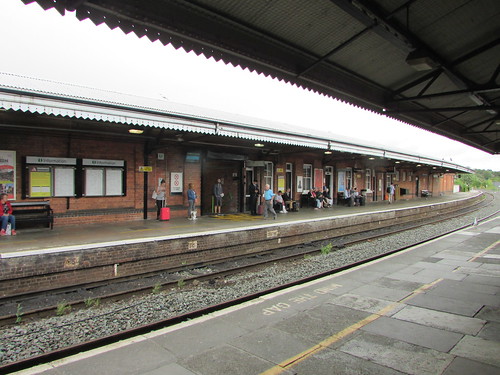
Worcester Area Rail: View from Worcester Foregate Street Platform 1 looking towards Rainbow Hill Junction, 28th July 2018.
Eventually, the following train for Hereford arrived, loaded up and set off southwards, passing over Foregate Street bridge which gives the station its name. The two parallel single lines are then carried over the 935 yard Worcester Viaduct and the River Severn before crossovers at Henwick Level Crossing signal box restore normal Up and Down running through Malvern Link and Great Malvern stations.
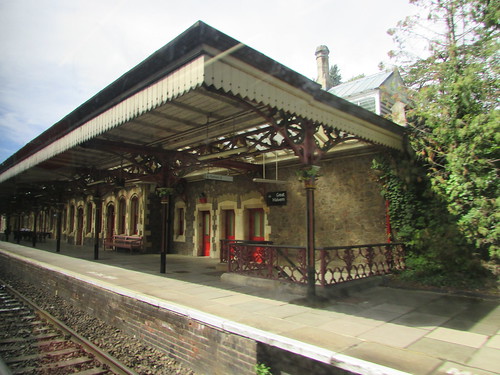 Worcester Area Rail: Great Malvern station Up platform, 28th July 2018.
Worcester Area Rail: Great Malvern station Up platform, 28th July 2018.
About one mile beyond Great Malvern station, at Malvern Wells signal box, the line singles through Colwall Tunnel (1536 yards) and Colwall station. After Ledbury Tunnel (1316 yards), Ledbury station has a passing loop but becomes single again before crossing over the 372 yard Ledbury Viaduct. Another 12 miles of single track leads to Shelwick Junction on the double-track Shrewsbury-Hereford Line. This junction is now remotely-controlled from Hereford, about 2-miles further on. My arrival at Hereford was 86 minutes late.
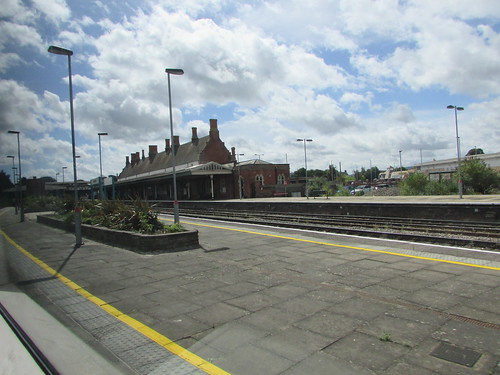
Hereford station buildings viewed from platform 1: 28th July 2018.
The 'Lionsmeet' event is described in the post here.
My return rail journey, via Shrewsbury, is described in the post here.
My pictures
Where necessary, clicking on an image above will display an 'uncropped' view or, alternately, pictures may be selected, viewed or downloaded, in various sizes, from one of the albums below:-
West Midland Railways.
Worcester Area Rail.
Shrewsbury-Hereford line (includes more pictures of Hereford station).
[Link to return journey added 11-Aug-2018, link to 'Lionsmeet' post added 26-Aug-2018]
One of the joys of property owning is the recurrent need for repairs. This is particularly the case with a building dating from 1640 which is also Listed Grade II. From time to time, I review some of the work carried out.
I think the first post describing external repairs covered 2014 and is here.
2016
Prior to the Garden Party at Brewood Hall in 2016 (described in the post here) repairs were carried out on the garden paths at the front of Brewood Hall. Work started with the delivery of materials by a large lorry equipped with a remotely-controlled self loading/unloading hydraulic crane.

Path repairs at Brewood Hall: OCL lorry (with a remotely-controlled self-loading/unloading hydraulic crane) delivering materials.
A couple of days later, a large skip was delivered to carry away spoil from the repairs.

Path repairs at Brewood Hall: Delivery of a large skip to carry away spoil.
The paths at the front of the building were relaid by Jim and Pete from A. M. Griffiths, together with Dave who has looked after the gardens (extending to about one acre) for some years.
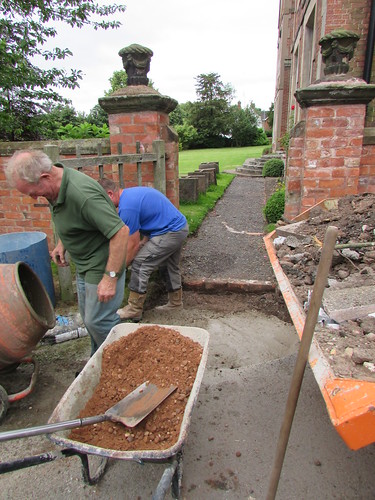
Path repairs at Brewood Hall in 2016.
2017
During 2017, improvements were carried out to the path at the rear of the building where damaged stone slabs were replaced by reclaimed paviours to better match the paved area outside the kitchen and the small barn. Further work will eventually improve the adjacent decorative cobbled area.
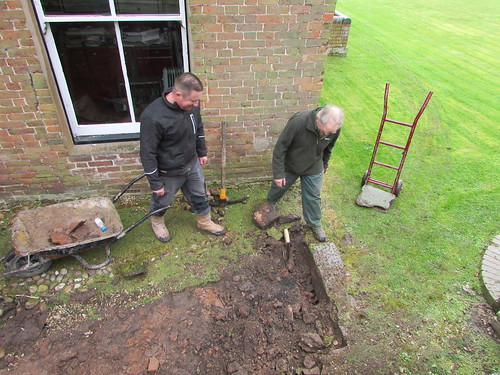
Brewood Hall: Jim and Dave working on repairs to path at rear.
To gain access to the front elevation allowing repairs to the decorative cement quoins, a 'Genie' Self-Propelled Articulating Boom Z-45/25 was hired in. Whilst the machine was on site, some high-level repointing of brickwork was also carried out. It was an amazing machine and I took some pictures from an elevated position. The work was completed prior to the Brewood Garden Party in 2017 (described in the post here).
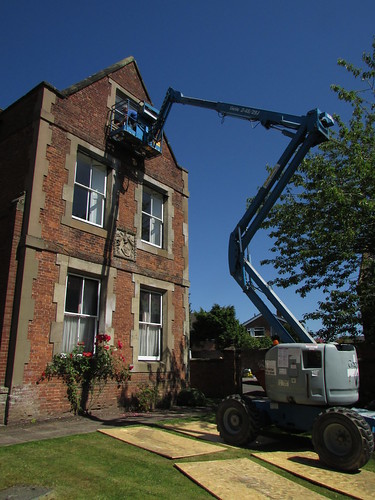
Repairs at Brewood Hall: 'Genie' Self-Propelled Articulating Boom Z-45/25
In November 2017 I visited Cawarden Brick and Tile Reclamation Yard near Rugeley with Brendan where we obtained sufficient reclaimed Staffordshire Blue Edgers for the front path which Dave later installed.
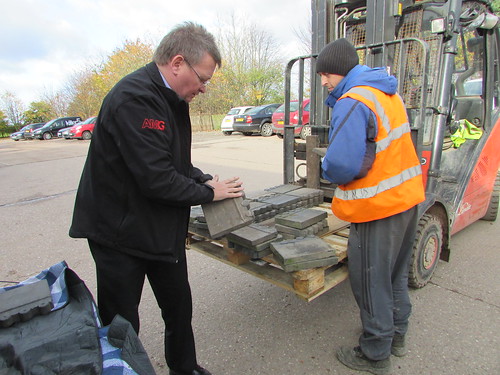
Cawarden Brick and Tile Reclamation Yard: Brendan inspecting reclaimed edgers.
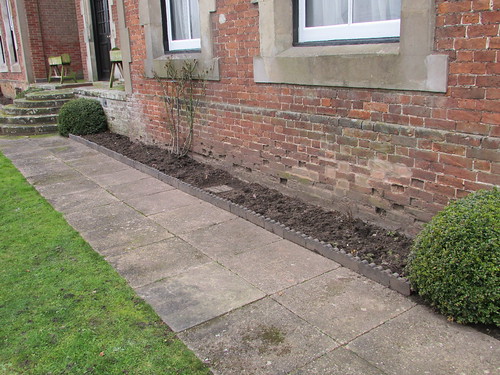
Brewood Hall Garden 2018: Reclaimed edging installed adjacent to the front path.
Related posts on this website
Brewood Hall Maintenance.
Brewood Hall Tree Maintenance.
To see all my posts on Brewood Hall, select Label 'Brewood Hall' or click here.
My Pictures
Where necessary, clicking on an image above will display an 'uncropped' view or, alternately, pictures from may be selected, viewed or downloaded, in various sizes, from the album below:-
Repairs at Brewood Hall.
Reclamation Yard.
Brewood Hall garden has a number of trees. Just as the Hall itself, a Listed Building, requires maintenance the trees also require periodic inspection and attention. The situation is complicated because all the trees are within the Brewood Conservation Area.
In 2012 a group of oak trees along one boundary were pruned for the second time and this is described in the post here.
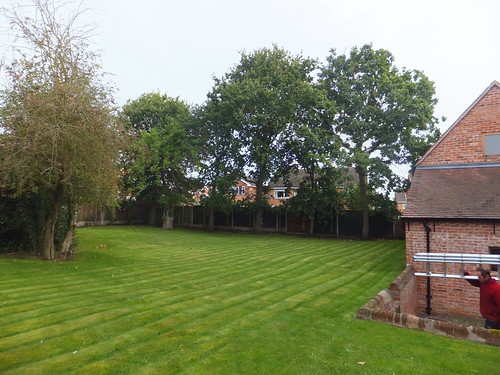
Oak Tree Pruning at Brewood
In September 2014, a self-set sycamore very near the front garden wall had to be felled. It had grown so as to threaten to demolish the garden wall. Although I'm not keen on sycamore, I'd given it a chance to grow clear of the wall but, of course. it didn't oblige. With a chain saw and an expert bit of rope work, Rik and Dave safely brought down the main trunk across the front lawn before quickly reducing the tree to a series of 'rounds'.

Sycamore felling at Brewood Hall, with Dave on the rope.

Sycamore felling at Brewood Hall: The felled tree reduced to a series of 'rounds'.
In contrast, I find silver birch attractive. My partner had planted one near the front gates in the 1980s as a replacement for a much older silver birch nearby which had been well-established when I came to Brewood in 1971 but had since died. The replacement tree lasted until 2017 when inspection showed that it was in danger of collapse so, reluctantly, I agreed to felling and Rik and Dave promptly carried out the work on 25th October 2017.
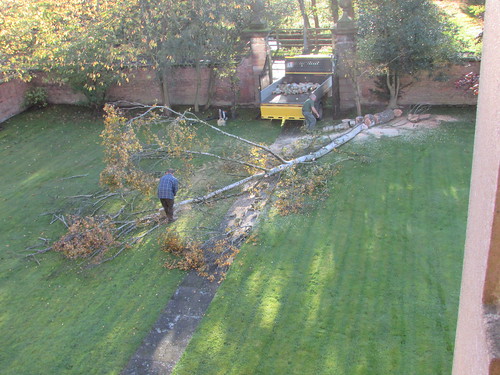
Tree felling at Brewood Hall: This view shows the height of the felled tree.
Related posts on this website
Oak Tree Pruning at Brewood Hall
My Pictures
Where necessary, clicking on an image above will display an 'uncropped' view or, alternately, pictures from may be selected, viewed or downloaded, in various sizes, from the album below:-
Oak Tree Pruning at Brewood.
Brewood Hall: Sycamore felling.
Felling of dying silver birch.
Even casual perusal of this blog is likely to reveal my enthusiasm for driving steam locomotives, latterly at a couple of preserved railways in the United Kingdom. At the Battlefield Line, I also drive the Diesel Multiple Units (DMU) owned by Ritchie Marcus and there's a steadily-increasing number of posts describing this (you can find them all here or by selecting 'DMU' from the list in 'Labels to select a blog topic').
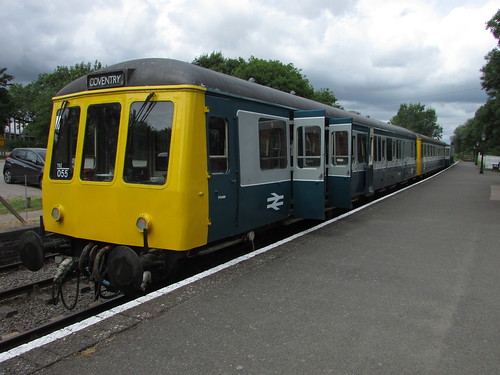
DMU Days at the Battlefield Line: After taking the school party to Shenton on 4th July 2017, the 1-car coupled to the 2-car set wait at Shenton prior to the return to Shackerstone.
In the summer of 2018, these diesel railcars provide the 'Midweek Services' on Tuesdays, Wednesdays and Thursdays so I seem to be getting regular DMU driving turns. I've always enjoyed driving the 'British Railways Modernisation' DMUs, which I remember from my own childhood when they were first introduced but the afflictions of increasing age make a 'diesel day' increasingly attractive for a number of reasons.
Firstly, preparation time is much reduced, compared with steam. 'Checking levels', as on a car, is required but the laborious 'oiling round' is avoided. Whilst a visual examination around the underframe is essential, once the engines are started, also from ground level, the driver can return to the cab whilst the compressors establish sufficient control air pressure to allow movement.
Secondly, driving is carried out whilst seated. Whilst I don't find the seat design particularly good (and manoeuvring around it is tight), it represents luxury compared with most steam locomotives which either make no provision for sitting or offer a rather mean wooden tip-up seat. Gresley is renowned for fitting a padded leather bucket seat on some of his steam locomotives. On most designs, many drivers (the writer included) preferred to remain standing to make the most of the poor forward vision offered by the cab design.
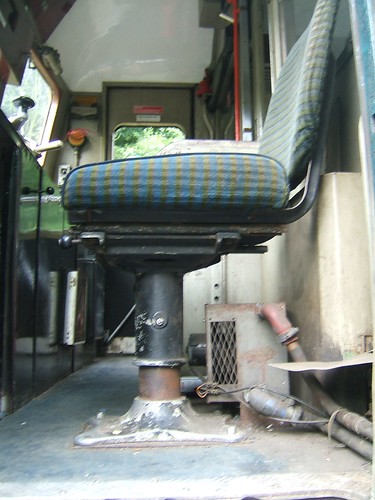
Detail of the driver's adjustable seat.
I often say '90% of a driver's attention should be focussed on the line ahead'. We can debate the exact percentage but keeping a good lookout is vitally important. The windows across the full width of the DMU cab give a panoramic view down the line very welcome to steam drivers brought up on leaning out of the cab to get reasonable sightlines around the front of the boiler. Provided the blinds at the rear of the DMU cab are raised, the passengers, too, can enjoy the view of the route ahead. The blinds were provided, of course, for use at night when the lights in the passenger compartment would otherwise damage the driver's night vision. More modern designs of diesel railcar reverted to solid walls between passengers and cab.
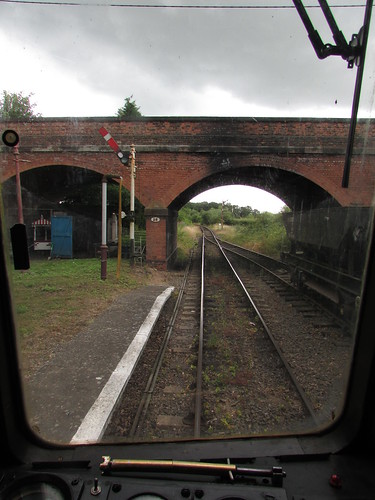
DMU Days at the Battlefield Line: Driver's view leaving Market Bosworth for Shackerstone.
On a steam-hauled train, to give the driver any chance of watching the line ahead, it's a requirement that the locomotive is a the front of the train (except where special arrangements are made called 'push-pull' or 'auto' trains). This means that, at each and of the line, there's a period of furious activity where the locomotive is uncoupled from the coaches, shunted to the other end of the train and re-coupled. On DMU, a driving cab is provided at each end of the train so that, at the end of the line, it's only necessary for the driver to 'close' what had been the leading cab, move to the other end of the train and 'open' what had been the 'back cab' so as to become the leading cab. The business of 'closing' and 'opening' cabs involves the transfer of an electrical master key and removable handles to control the final drive and braking systems.
Although the supply of coal carried by a steam locomotive is normally arranged to suffice for a whole day, the water supply (which is boiled to produce steam, used to impel a piston up and down a cylinder producing useful work and then discharged as exhaust steam from the chimney) often requires replenishment a number of times a day. By contrast, a DMU may be able to run for a number of days before the diesel fuel tanks require topping-up and water (used to cool the diesel engines, as in a car) is recirculated.
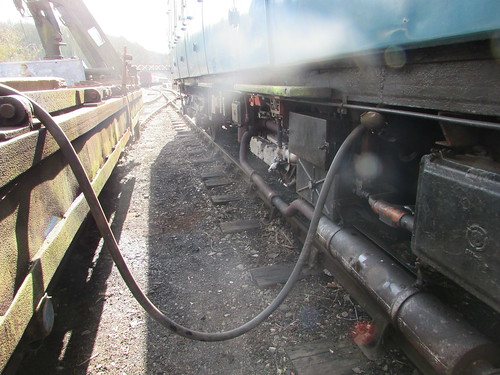 Refuelling the DMU at Shackerstone.
Refuelling the DMU at Shackerstone.
On a DMU, the driving controls, instruments and indications are laid out on the desk in front of the driver in a reasonably ergonomic manner unheard of on steam locomotives although Riddles, in designing the British Railways 'Standard' steam locomotives, attempted a convenient layout.

The driving controls, instruments and indications are neatly laid out on the desk in front of the driver.
Drivers also appreciated the 'power on demand' nature of the DMU. With steam traction, the power available to work the train depended upon many factors including time since last 'shopping', time since last boiler washout, quality of coal and, not least, attitude and competence of the fireman. In contrast, a DMU normally works as intended or doesn't work at all. That's a bit of a simplification but, in general, when a diesel driver opens the throttle, the power will flow, giving the driver a feeling of confidence that the job will go well.
But perhaps the best feature of working on a DMU is the opportunity to meet passengers. Many passengers seek out a seat in the leading coach where they can see the line ahead and watch the driver at work. In stations, passengers (men, ladies and children) can often be seen studying the cab and may ask questions. When working on steam, although we always try to acknowledge anyone nearby, the workload involved hinted at above means that a protracted chat is rarely possible. In contrast, when working on a DMU there are better opportunities for passengers to take photographs of the driver's 'office' or to answer questions (admittedly at the risk of boring them to tears - 'too much information'). I never cease to be amazed at the interesting backgrounds and experiences of our visitors. And, at the end of the day, I'm not quite as shattered (or dirty) as after a steam 'turn'.
On Saturday, 7th July 2018, the Brewood Garden Party was held, for the sixth time, in the garden at Brewood Hall. The event is organised by 2nd Brewood Scouts, Brewood Parish Church and the informal group Friends of Brewood Hall. All of the work organising and running the event is carried out by volunteers.
Preparations
As in previous years, there was an organising committee who met a number of times in the months prior to the event to ensure that visitors enjoyed their visit on the day. 'Flyers' had been distributed around the village, posters and a banner had been put up and there were announcements on social media. Erection of the tents and stalls was started on the evening of Friday, 6th July, using a different layout to previous years which proved popular.

Brewood Garden Party 2018: Setting-up on Friday: Methodical erection of the craft marquee.
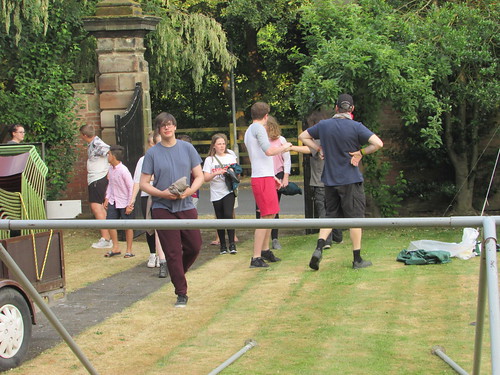
Brewood Garden Party 2018: Setting-up on Friday: Welcome reinforcements!
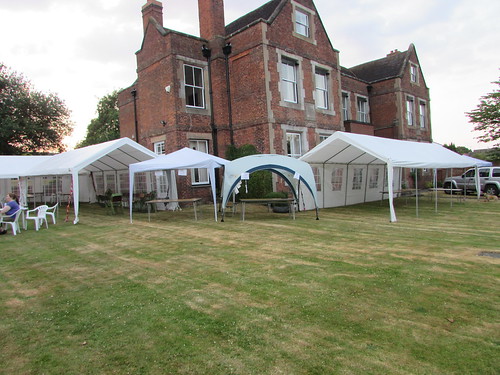 Brewood Garden Party 2018: Setting-up on Friday. L-R: Band tent, Pimm's Tent, Tombola tent, Craft Tent.
Brewood Garden Party 2018: Setting-up on Friday. L-R: Band tent, Pimm's Tent, Tombola tent, Craft Tent.
Setting-up was completed on Saturday morning, following an early start, so as to be ready for the opening at noon.
The Event
The whole week had been warm and Saturday was the same. All the usual stalls and diversions were provided, plus some innovations.

Brewood Garden Party 2018: Admission desk at front gates.
The Staffordshire Corps of Drums opened the proceedings with an impressive display. They admitted that, in the heat, the woollen uniforms were very uncomfortable.
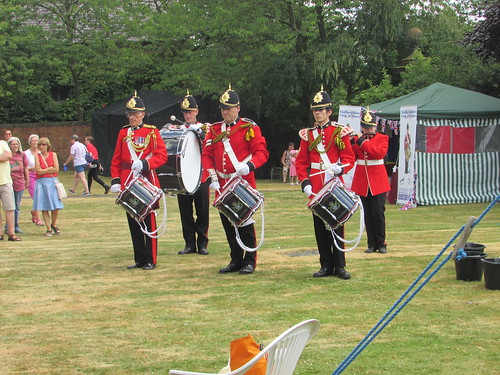
Brewood Garden Party 2018: The Staffordshire Corps of Drums opened the proceedings.
The Refreshment Tent quickly became busy and remained busy. This year, the local Midland Counties Co-op store provided additional help which was very welcome.
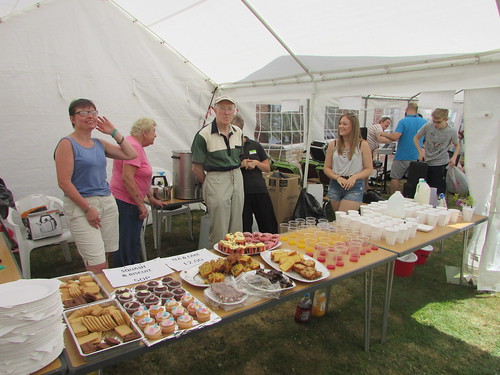
Brewood Garden Party 2018: A wide range of snacks were available in the popular Refreshment Tent.
For the first time, local traditional butchers Maiden's offered hot dogs, burgers and frozen snacks.

Brewood Garden Party 2018: Maiden's ready for business.
The Pimm's Tent, Tombola and Plants and Produce stall remained popular.
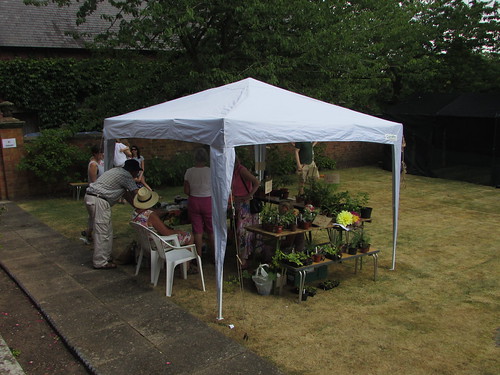
Brewood Garden Party 2018: Plants and Produce Stall.
The Craft Tent featured the work of a number of local artists and crafters.

Brewood Garden Party 2018: Jan with local artist Rob.
Black Country Live Steamers appeared again with two immaculate miniature traction engines and, located in the driveway, were able to give rides.
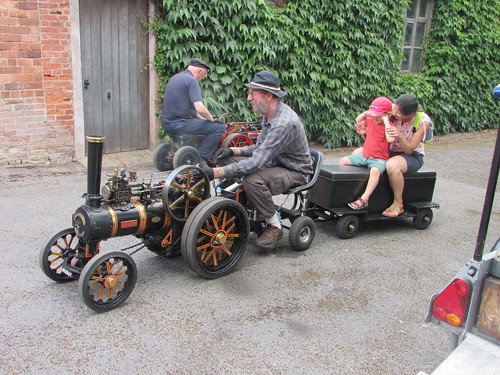
Brewood Garden Party 2018: Miniature traction engines from Black Country Live Steamers.
Chase Ferret Rescue were appearing for the first time. They had brought a number of ferrets and everybody was most impressed by the quality of the accommodation provided for the ferrets and the knowledge and care displayed by their volunteers.

Brewood Garden Party 2018: The Ferret Rescue stand.
I'd never handled ferrets before and I admit I was entranced by the creatures.

Brewood Garden Party 2018: Jan makes friends with a young ferret.
To appeal to our younger visitors, we had the Coconut Shy, Catapult Range and Wet Sponge Throwing together with the supervised Kids' Under-5 Zone.

Brewood Garden Party 2018: A busy time at the Kids' Under-5 Zone.
A new attraction in 2018 for children was the Toys and Sweets stall.
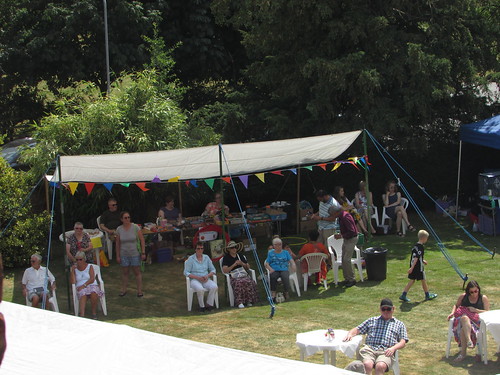
Brewood Garden Party 2018: View of Toys and Sweets Stall which also provided welcome shade to some visitors.
Later in the afternoon, there were Egg and Spoon and Sack Races.

Brewood Garden Party 2018: Childrens' Sack Race.
Everyone was delighted that, once again, the Cannock Bands, based at the Cannock Performing Arts Centre, returned to play for us.

Brewood Garden Party 2018: Cannock Wind Band performing. Because of the heat, they were not in their customary black uniforms.
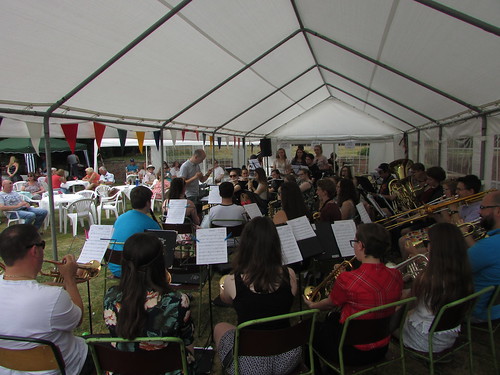
Brewood Garden Party 2018: Cannock Big Band performing: The view looking towards the audience.
Finally, the Staffordshire Corps of Drums gave a second display.

Brewood Garden Party 2018: A second performance by the Staffordshire Corps of Drums.
In choosing the date for this year's garden party, the organising committee were faced with the difficult problem of trying to avoid competing attractions. What they could not have known was that the English football team would achieve a measure of success in the World Cup being played in Russia, resulting in the team having a match starting at 3.00 p.m. on the day of the garden party. A mass early exodus was anticipated with people seeking to watch the match on television. The timing of the band performances at the garden party was brought forward to help and the Scouts brought their 50-inch plasma television. This was set up in the band tent (after the band performances) and hooked-up to the Brewood Hall aerial system, allowing people to remain on site and watch the game!
England lost in their World Cup match but lots of people confirmed that the Brewood garden party had been a splendid event.
Reports on earlier garden parties at Brewood Hall
Brewood Vintage Garden Party 2013.
Brewood Vintage Garden Party 2014.
Brewood Garden Party 2015.
Brewood Garden Party 2016.
Brewood Garden Party 2017.
Pictures of the event
Where necessary, clicking on an image above will display an 'uncropped' view or, alternately, pictures from may be selected, viewed or downloaded, in various sizes, from the album below:-
Brewood Garden Party 2018.
In 2018, the Battlefield Line was closed until Easter to allow track relaying to be carried out.
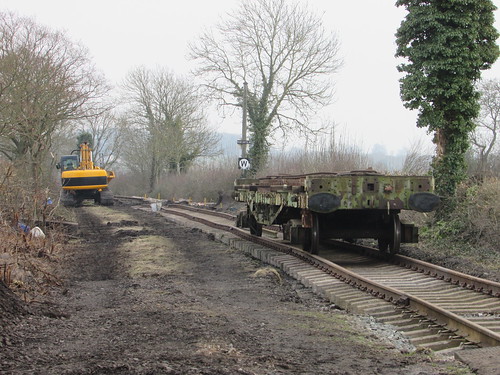
Battlefield Line, early 2018: Relaying south of Headley's Crossing.
Whilst the railway was closed, in connection with testing work for an outside client, I did drive the single unit diesel railcar on a few days. This was confined to running between Shackerstone and Headley's Crossing.
My first passenger turn at the Battlefield line in 2018 was on Wednesday, 4th April, just after Easter, when the 2-car Diesel Multiple Unit was rostered. That day didn't go quite to plan and I ended up operating with the single unit diesel, as described here.
Then, I was overseas for a few weeks in Myanmar (Burma), as described in a series of posts starting at Travelling again.
So my first steam 'turn' at the Battlefield Line in 2018 wasn't until the Fish and Chip Evening Special on 9th June 2018. The popular 'Fish and Chip' trains operate on a number of dates during the year and I described an earlier 'Fish and Chip Special' (using 'Cumbria') here.
Events of 9th June 2018
Carl was rostered as driver for the five service trains during the day but he asked if I'd care to take the last round trip as he was Signalman for the evening 'Fish and Chip' train. So I was waiting on platform 2 at Shackerstone when the 'Light Prairie', 5542, arrived after the fourth round trip.

Battlefield Line, 9th June 2018: 5542 drifts into Shackerstone on the 4th service train of the day.
Carl turned the engine over to me, Tracy uncoupled and we ran around the train, pausing for water before coupling onto the train ready for the 4.15 p.m. departure to Shenton.

Battlefield Line, 9th June 2018: Carl dismounts from 5542 on arrival back at Shackerstone with the 4th service train of the day.
We operated the last round trip to Shenton and on arrival back at Shackerstone were routed into platform 1 where the main station facilities (tea room, museum and toilets) are located. There was then plenty of time to uncouple and run round, stopping to fill the side tanks at the water column on platform 2. Now hooked onto the south end of our four coach train, the engine simmered as we waited for our 80 guests to arrive.

Battlefield Line Fish and Chip Evening Dining train, 9th June 2018: Waiting for our guests to arrive.
Slowly, the train filled with our diners and at 7.00 p.m. we received the 'Right Away' from the Guard. I gently started the train away, complied with the 5 m.p.h. speed restriction on the crossover leading to the single line and collected the Single Line Staff from the Signalman. There's a 10 m.p.h. speed restriction passing through the cutting to Barton Lane road bridge but once clear of the 'slack' I only let the speed rise a little - we were in no hurry on this trip as we trundled down the line and the tantalising smell of fish and chips wafted towards us from the train.
We were not booked to stop at Market Bosworth but we slowed right down when passing through the platform, allowing staff on the train to pass a portion of fish and chips to one of our Volunteers waiting on the platform. Once the delivery had been safely made, I let speed rise a little as we passed into the gently uphill cutting section spanned by three successive overbridges which took us towards Shenton. Once clear of the cutting, the line became gently downhill on Shenton Bank with views across the Leicestershire countryside on both sides of the train.
Near Shenton's fixed distant signal, I brought the train to a gentle stop so that our diners could admire the peaceful spot as they enjoyed their meal. Whilst at a stand, the locomotive crew were also issued with fish and chips - a welcome treat!.

Tracy enjoys her fish and chips.
After ten minutes or so, we received the about 'Right Away' from the Guard and trundled into Shenton station. There was then a few minutes of activity as we uncoupled, ran round and coupled back onto the train ready for the journey back to Shackerstone. It was a warm evening, still light and many passengers came onto the platform to take photographs or simply admire the locomotive. After a while, the train staff persuaded everybody back on board and the Guard gave the 'Right Away'. We were told to take it gently to Market Bosworth and then complete the journey at Line Speed, so we were able to have an enjoyable 'romp' to complete the trip. We were routed into platform 1 and, as our happy passengers made their way back to their cars, Tracy uncoupled to the final time. It didn't take us long to shunt onto the shed and complete disposal.
Related posts on this website
Battlefield Line Fish and Chip Evening Special (an earlier 'Fish and Chip' train).
To see all my posts about the Battlefield Line, select Label 'Battlefield Line' or click here.
My photograph albums
Where necessary, clicking on an image above will display an 'uncropped' view or, alternately, pictures may be selected, viewed or downloaded, in various sizes, from the albums listed:-
5542 GWR Locomotive
Battlefield Line, 2017-2018
All my Battlefield Line albums
Events of Saturday, 2nd June 2018
I travelled to Ely where Ann Matthews was "being presented" at the Open University Degree Ceremony in Ely Cathedral having graduated as Master of Arts in History. Five years previously, I'd made the same journey for her Bachelor of Arts Ceremony (that day is described here).
The Rail Journey
I took a taxi to Wolverhampton and train to Birmingham. From here, Cross Country still operate a service to Stansted Airport. A 2-coach 'Turbostar' DMU was deemed appropriate that day and we made a fairly leisurely progress through Nuneaton and Leicester onto the Peterborough line, still equipped with semaphore signals and manual signal boxes. At Oakham, we stopped but remained in the station. After a few minutes, the lady Train Manager (or whatever they are calling Train Guards at present) announced over the public address that we were awaiting Police to deal with a disruptive passenger. About twenty minutes later, a single police officer boarded the train. The passenger had clearly been disruptive very quietly as I was surprised to find that I was only a couple of seat rows away from him. Very politely, I heard the Officer explain that the passenger would not be allowed to travel further since the Train Manager claimed he had been rude. After further discussion, the passenger and police officer got off the train which then continued on its journey. Beyond Peterborough, we entered a former Great Eastern Railway line, which also retains semaphore signalling. Crossing this flat landscape through March towards Ely, there are numerous level crossings (mainly automatic half-barrier). We managed to lose a further ten minutes because of a signalling failure before joining the overhead electrified line from Kings Lynn at Ely North Junction, two miles north of Ely station where I left the train which continued through Cambridge to Stansted.

Ely Station, 2nd June 2018.
Railway Maps
'Railway Track Diagrams Book 4: Midlands & North West', Second Edition, published by Trackmaps (ISBN: 0-9549866-0-1).
'Railway Track Diagrams Book 2: Eastern', Third Edition, published by Trackmaps (ISBN: 0-9549866-2-8).
My railway pictures
West Midland Railways.
Nuneaton Station.
Leicester area rail.
Ely Station
The Ceremony
I walked as fast as I could from the station to Ely Cathedral to meet Ann, Dean and Dean's sister and we took our positions for the ceremony. The packed cathedral formed a suitably impressive venue. Ely Cathedral is famous for its architecture and for the remarkable octagonal tower above the nave crossing.

Ely: 2nd June 2018: The tower above the nave crossing.
A temporary stage had been built at the nave crossing for the Open University dignitaries.

Ely: 2nd June 2018.
With a few hundred presentations to be made, the business was carefully choreographed and proceeded briskly. Ann was presented fairly early in the morning's proceedings.

Ely: 2nd June 2018: Ann Matthews being presented.
At the completion of the presentations for the morning session, everybody trooped outside into the bright sunshine where something of a carnival atmosphere prevailed.

Ely: 2nd June 2018
We spent the afternoon enjoying the town and the market before having a celebratory meal at an Italian restaurant. Ann and Dean drove me to the station (they were staying overnight in Cambridge) and I had time to explore the station before catching a very crowded train back to Birmingham, then on to Wolverhampton and a taxi home.
My pictures of Ely and the ceremony
Ely 2018
Sunday, 13th May 2018
I awoke on Sunday to find it raining although not cold. The hills were shrouded in mist. As arranged, morning tea was served in my lodge at 6.30 a.m. Breakfast was available in the main lodge between seven and nine and the rain had stopped when I went up the stone path for my meal. The stillness of the mountain top location was very relaxing and, after breakfast, I was quite happy to wander around the main lodge, studying the layout.
An engraved brass plate commemorated those involved in the creation of the lodge, which was opened by Sir Edmund Hillary in 1998 and has since hosted Prince Charles and Princess Anne.
During the day, the mist lifted and it was pleasantly warm, but without the bright sunshine of the previous day. After lunch, one of the guides induced me to take a short trek with him to the nearby village, although I was a bit worried about the terrain and my impaired mobility. I armed myself with a wooden stick from the lodge (albeit rather long for me) and we safely completed the walk, including a rather stiff climb up a hill to a viewpoint which I'd seen from my lodge. At the viewpoint was an abandoned house, now used as a rendezvous by the young people of the district. We also met my guide's wife, who was displaying jewellery and artefacts.
In the evening, the same friendly group of four dined together. I'd enjoyed the day immensely, although not done a lot. I retired a little earlier than the previous night but was woken up during the night by the crashing thunder of a furious thunderstorm.
Related posts on this website
This is one of a series of posts describing my first visit to Nepal. Clicking on the 'Next report' link displays the post describing the next events. In this way, you may read about the trip in sequence.
Next report.
Alternately, clicking on the 'All my Nepal reports' link displays all the posts on this trip in reverse date-of-posting order.
All my Nepal reports.
My pictures
Tiger Mountain Pokhara Lodge
Trek at Tiger Mountain Pokhara Lodge, 13th May 2018
All my pictures on this trip to Nepal can be found in the collection Nepal.
[Pictures linked 8-Aug-2018]
Tuesday, 15th May 2018
I'll describe my journey back to Kathmandu and my sightseeing in nearby Bhaktapur City on Monday, 14th June when I can.
After a comfortable night at Dwarika's, I'm about to set off on the long journey home. It should be Qatar Airways A320 to Doha on the QR649, transiting to a 787-8 on flight QR023 to Manchester. The last few weeks have certainly earned the title 'Journey of a lifetime'.
Related posts on this website
This is one of a series of posts describing my first visit to Nepal. Clicking on the 'Next report' link (where shown) displays the post describing the next events. In this way, you may read about the trip in sequence.
Alternately, clicking on the 'All my Nepal reports' link displays all the posts on this trip in reverse date-of-posting order.
All my Nepal reports.
Clicking on the 'All my Burma-2018 reports' link displays all the posts on my time in Myanmar prior to arriving in Nepal, again in reverse date-of-posting order.
All my Burma-2018 reports.
My pictures
Tiger Mountain Pokhara Lodge
Tiger Mountain, Pokhara, Nepal
Pokhara, Nepal
Pokhara to Kathmandu by Buddha Air Beech 1900D
Kathmandu Airport
Kathmandu
Dwarika's Hotel, Kathmandu
Bhaktapur City, Nepal
Nepal from above
All my pictures on this trip to Nepal can be found in the collection Nepal.
[Pictures linked 8-Aug-2018]
Saturday, 12th May 2018
The main building of the Tiger Mountain Pokhara Lodge is large, single-storey, stone built, with lots of glazed doors which give access to an open terrace with superb views over the valley below with snow-clad mountains in the background. At one end of the building, the kitchen is at a lower level, forming a basement area. There were lots of male staff in attendance, all English speakers.
"Your lunch is ready", they announced, setting a brass tray with lots of small dishes and rice at a table on the terrace. It was Nepali-style cooking. I enjoyed what I was able and then, no doubt to the disappointment of the Chef, arranged that I would stick to bland, European-style food for the rest of my stay.The sun was warm and visibility good that afternoon: thereafter it remained cool with moderate to poor visibility, for which they apologised. But I enjoyed the ever-changing, rather mysterious views of mist-shrouded mountains.
I believe they have 19 lodges for guests. Appropriately, I was given number 7, the nearest to the main lodge, which still involved a flight of stone steps and a steep path rough-hewn into the living rock. My lodge was well-appointed with a very large double bed and a single bed. I selected the double bed. A section at one end of the lodge had a shower, wash handbasin and W.C. A covered terrace outside the front door was furnished with a table, easy chair and staggering views across the valley. I knew I would enjoy my brief stay.
After my early start that day to take the Mountain Flight from Kathmandu, I was happy to spend the rest of the afternoon in my room backing up photographs and preparing text offline for the blog. I was told that dinner was 'seven for seven-thirty' and found, because it was near the end of the season, only two other guests, Hannah and Oliver Knight, a young couple from London. Our host was the English manager of the lodge, and we dined together very agreeably at a table for four set up in an annexe to the large dining room. I'd remembered to bring the wind-up torch from my room to light my unsteady way back to my room, but the path was also lit by a number of paraffin Hurricane lamps which produced a nostalgic aroma. Exhausted, I slept well.
Related posts on this website
This is one of a series of posts describing my first visit to Nepal. Clicking on the 'Next report' link displays the post describing the next events. In this way, you may read about the trip in sequence.
Next report.
Alternately, clicking on the 'All my Nepal reports' link displays all the posts on this trip in reverse date-of-posting order.
All my Nepal reports.
My pictures
Tiger Mountain Pokhara Lodge
All my pictures on this trip to Nepal can be found in the collection Nepal.
[Pictures linked 8-Aug-2018]
Saturday, 12th May 2018
The late running of my early morning Mountain Flight meant that I had less time than planned for breakfast at Dwarika’s Hotel but I had an omelette, tomato juice and tea provided promptly by the attentive staff in the restaurant. I had decided to travel light for my trip to Pokhara so I crammed a few clothes in my rucksack with my computer and put two bags in the hotel’s luggage store until my return. At ten o’clock my guide, driver and the writer set off back to the airport I’d so recently left. The police presence was even more intense: police lined both sides of the main road every 50 yards and there were periodic groups of paramilitary ‘riot squads’, supported by lorries marked ‘Mobile Rest Room’.
At Tribhuvan Airport, I now knew the system for embarking on domestic flights. My booking to Polhara was on the noon flight. The pleasant young man who’d earlier issued my boarding pass for the Mountain Flight recognized me and explained that, because flights were disrupted by the VVIP visit, he was booking me on flight U4 609, due to leave at 10:35 but that this would leave late. I went through security and secondary security into the crowded, noisy Gate Area. On the Buddha Air Flight Information screen, many flights, including mine, had the note ‘DELAY DUE TO VVIP MOVEMENT’. Occasionally, painstaking amendments would be made to the display, or the Windows start-up screen would appear for a while or the public screen would shut down and require re-start by a member of staff with a hand-held remote control. Having found a seat with a view of the Flight Information screen, I stayed put. Thus, the morning slowly passed. Around 12:30, my flight was called and passengers filled up a couple of transfer buses. Then we waited. The Thai flight from Bangkok which I’d arrived on the previous day landed, an ATR-62 local flight took off, followed by a twin jet. Then a Malaysia Airlines 737-800 landed and taxied to the stand, followed by a Simrik Airlines local flight. Kathmandu is a very busy airport. After 20 minutes, the bus drove across the apron to the domestic flight line, where we stopped adjacent to a Buddha Air ATR-62 turbo-prop. Another wait followed. Then we boarded the aircraft and there was a further wait whilst the two stewardesses plied us with peanuts, a fruit drink and water. Suddenly, the engines were started, our snacks were hurriedly cleared away and we taxied to the runway.
We rapidly climbed away from Kathmandu, and emerged above the clouds with views of snow-clad peaks brightly lit by the sun on our right. Before long, we descended through the clouds to a plain well covered with buildings – Pokhara is, I think, the second largest city in Nepal after Kathmandu. The approach to Pokhata is interesting. When approach flap was selected, I knew we were getting close to landing, but I couldn’t spot the runway ahead. Then we commenced a steep right bank, turned right and kept turning. As we continued to turn, I saw what appeared to be a new runway under construction further out on the plain. Just before the runway threshold, the pilot levelled out and we made a fairly fast landing. Landing at Pokhara can be quite a challenge for pilots, so I could see why a new airport is being built, presumably with easier approach from the air. We walked from the aircraft to a small baggage hall but with hand baggage only, I was quickly in the small car park looking for the representative from Tiger Mountain Lodge. I located him and we set off in a black Land Rover through the centre of Pokhara, larger than I expected. A straight main road led us through ribbon development for a few kilometres then the scenery became more rural and we turned off the main road onto a steeply-inclined road ascending Tiger Mountain. It soon became clear why we were using a Land Rover as the narrow road twisted and turned up the mountain through a series of tight hairpin bends. An unsurfaced lane led us to a small car park from where we walked up a path cut into the rock and climbed stone steps to enter the main building of Tiger Mountain Lodge, my home for two nights.
Related posts on this website
This is one of a series of posts describing my first visit to Nepal. Clicking on the 'Next report' link displays the post describing the next events. In this way, you may read about the trip in sequence.
Next report.
Alternately, clicking on the 'All my Nepal reports' link displays all the posts on this trip in reverse date-of-posting order.
All my Nepal reports.
My pictures
Nepal from above
Kathmandu Airport
Kathmandu
Dwarika's Hotel, Kathmandu
Pokhara, Nepal
Tiger Mountain, Pokhara, Nepal
Tiger Mountain Pokhara Lodge
All my pictures on this trip to Nepal can be found in the collection Nepal.
[Pictures linked 8-Aug-2018]
Saturday, 12th May 2018
To cater for the interest of tourists in the Himalayan mountains and, of course, Mount Everest there are daily flights from Kathmandu airport to view the peaks. The weather can be very changeable so good views and the flights themselves are not guaranteed. There are a number of similar flights each day, all operating early morning to secure the best views.
I was booked with Buddha Air, due to leave at 06:15 but I was warned that flight times are notoriously variable, according to weather conditions. In addition, we had the movements of Indian Prime Minister Mr. Modi to contend with, hence I was picked up by my guide at 4.30 a.m. The guide said the flight would be affected by Mr. Modi’s planned visit to a temple. The flights leave from Tribhuvan Airport where I’d arrived the previous day but there’s a separate Domestic Terminal for internal and ‘Mountain’ flights. The guide wasn’t allowed into the terminal building so he described the arrangements I’d find. First, there was a ticket and passport check, then hand baggage was X-rayed and, after passing through a detector arch, there was a body search (separate for men and women). I was then in a noisy, barn-like Ticket Hall where I found a group of Buddha Air check-in counters, most with a destination board hung up. I queued at the one with the sign ‘MOUNTAIN’ and was issued with a boarding card by a friendly young man who, like a lot of the people I met, spoke good English. I then passed into a crowded waiting area but noticed that many people were passing through a secondary security to what appeared to be the Gate Area. Since there was no passenger information screen in the waiting area, I went through security to an even more crowded, even noisier gate area. There were a couple of fairly standard display screens but the Buddha Air flights weren’t shown.
But near one of the two gates, there was a single counter with a display screen above in a frame marked Buddha Air Flight Information. There were six ‘Mountain’ flights shown, all departing at 06:15. As I watched, the screen started to change, but slowly, one character at a time. To confirm my suspicions, I walked to the side of the counter and there was a screen and keyboard with a girl typing in the day’s schedule from a printed list originated by another system. It rather looked as if she was using Word, Excel or Access to create the schedule and that the public display was simply a second screen on her computer. New entries appeared in a very small font, so each field was laboriously resized individually, with all the option menus appearing on the public display as well. Occasionally, an existing field would be copied to save retyping. I was fascinated watching this lengthy process and realized that all changes throughout the day were going to be made by this labour intensive process. There was a permanent crush of people around the desk, bombarding the girl with questions but I decided that I could probably use the screen as a source of information. Northing else happened for a while, except that more people arrived in the Gate Area. Then all the ‘Mountain’ flights were bracketing together on the display with the ominous message ‘AIRPORT CLOSED DUE TO VVIP MOVEMENT’. Initially, the girl had type ‘VIP’ but one of her colleagues suggested that she amend it to read ‘VVIP’. To get the remark in red characters, she had to use another sub menu to select colour. A few minutes later the message was amended to ‘AIRPORT CLOSED FOR SOMETIME DUE TO VVIP MOVEMENT’.
A loud roar announced the manoeuvring of a large Indian Air Force helicopter, which was presumably about to fly Mr. Modi on his temple visit. Everybody became very excited and rushed towards the windows to watch. Presumably Mr. Modi had left, because they started to board Mountain flights.
Eventually, my flight was called and a small group of passengers were ushered onto a transfer bus. Three or four other Indian Air Force helicopters started manoeuvring – presumably a backup, the Prime Minister’s entourage and perhaps the Press Corps. The transfer bus drove across the apron and stopped adjacent to a Buddha Air twin-engined Beechcraft. Then we waited. One or two aircraft took off and a fuel bowser replenished the aircraft next to us and then both wing tanks of the Buddha Air Beechcraft. A stewardess looked out of the cabin door, then retreated inside. The pilot was clearly on board, as I watched him exercise ailerons and rudder for “full and free movement”. At last, we boarded the aircraft and took off about 75 minutes late.
We climbed rapidly above the clouds and then the ragged, snow-covered outline of the Himalayas appeared on our left. The seating was 1+1 with a window by every seat but visibility was not too good and as the flight proceeded, the cabin windows started to ice-up. I presume that’s why the stewardess started to call passengers, one by one, to the front of the aircraft where the flight deck windows were all heated. It was all a bit confusing, with passengers moving forwards and backwards in the narrow aisle and crossing a slight ‘hump’ halfway down the cabin where the main wing spar passed under the floor. I didn’t positively identify any mountains at the time, but perhaps I’ll be able to later. We turned to make our return to Kathmandu with the mountains now on our right (the side I was sitting). The icing grew worse as we dropped below the clouds. I heard the rumble from the actuators as the co-pilot selected approach flaps. As we neared the airport, full flaps were selected to reduce the stall speed for landing and after touch-down we taxied to the domestic apron. A transfer bus returned us to the Domestic Terminal and, just outside, my guide was waiting. The same people carrier and driver returned me to Dwarika’s for breakfast but, this time, we were able to use the ‘posh’ front entrance.
Related posts on this website
This is one of a series of posts describing my first visit to Nepal. Clicking on the 'Next report' link displays the post describing the next events. In this way, you may read about the trip in sequence.
Next report
Alternately, clicking on the 'All my Nepal reports' link displays all the posts on this trip in reverse date-of-posting order.
All my Nepal reports.
My pictures
Nepal from above
Kathmandu Airport
Mountain flight, 12th May 2018
Kathmandu
Dwarika's Hotel, Kathmandu
All my pictures on this trip to Nepal can be found in the collection Nepal.
[Pictures linked 8-Aug-2018]
Friday, 11th May 2018
Early Friday morning, I’d been booked to leave Yangon on the Bangkok Airways flight PG706 to Bangkok leaving at 5.50 a.m. Eddie Teh kindly suggested that I stay at the Belmond Governor's Residence on Thursday, allowing me to upload some pictures to the internet. This had the advantage that, rather than worry about my departure, Doctor Hla Tun could concentrate on his own flight Friday morning to Bagan, where he would no doubt face another gruelling weekend of consultations at Bagan Medical Clinic.
It was recommended to report to the airport at least two hours before departure for international flights so the hotel car dropped me at the airport about a quarter to four in the morming. There were a few travellers waiting outside the terminal building being held at bay by a rather aggressive young lady with a machine gun. Staff were arriving through the one entrance which was open but passengers were not allowed inside until 4.00 a.m., when I was the first person to enter and pass through a very friendly security check (ticket and passport checked, luggage X-rayed, passengers first through a detector arch then a cursory ‘frisk’ with a ‘wand’). I quickly found the Bangkok Airways check-in counters but it didn’t do me much good – they were all unstaffed. I chose to sit down and wait with my luggage nearby but younger, later arrivals formed a queue at the check-in counter. Eventually, staff arrived and spent some time meticulously preparing for the day’s work and two girls logged on to their booking system. One man appeared with a large plastic storage box from which he unloaded all the various notices to passengers which sit on top of the counters and, a nice touch, a potted plant for each of the three counters. Two of the three desks were staffed and they started check in. This process soon slowed as one of the computer screens stopped working. Just before my turn came, they managed to coax the failed screen back into life. After this frustrating start, the actual flight to Bangkok was uneventful, if noisy, as there was a party of about twenty Thai ladies on board who kept up loud chatter and laughter throughout the journey.
Bangkok Airport is huge. After we landed, it took us over ten minutes to taxi to the stand, then at least as long for the transfer bus to ferry us to the terminal. Then, I had to find the Transfer Desk and get my boarding pass for my onwards journey. The signs said that there were two transfer desks, one East, one West and each a few hundred yards away from me. I couldn’t work out which was appropriate to my flight, so I guessed (a 50-50 shot) and was lucky. A lot of walking and moving pavements took me to a very thorough Transit security check (all items in blue plastic trays for X-ray, shoes in red plastic tray for X-ray, whole body scan cubicle, cursory body search) which, combined with rather officious security staff, always spoils my mood. At least I was near the correct Transit Desk, obtained my boarding pass for the onwards journey to Kathmandu, Nepal, and took refuge in the nearby Thai lounge for a few minutes.
I only had a short walk from the lounge to the departure gate, too, and a transfer bus took us to a remote stand and our waiting aircraft. Matters quickly improved as the cabin service was excellent. It was a busy time at the airport with a stream of aircraft waiting to use the departure runway and it took at least 30 minutes of queuing and taxiing on the ground before our aircraft took off.
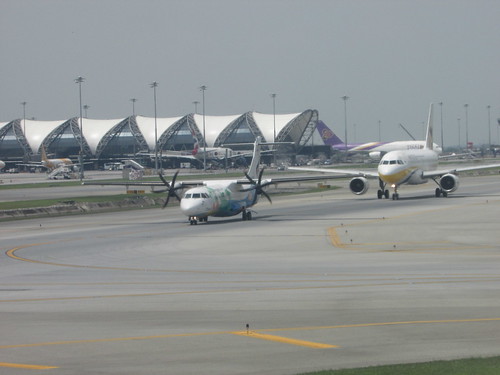
Yangon to Kathmandu via Bangkok, 11th May 2018: The queue of aircraft waiting for take-off extended behind my aircraft.
I enjoyed a very decent lunch on the flight. I was surprised that there was no multi-channel passenger entertainment system but a copy of the ‘Bangkok Post’ kept me engrossed for most of the journey.
Of course, our route to Nepal took us back over Myanmar and, eventually, over the mountainous terrain approaching Kathmandu. I had not expected such a large, sprawling conurbation of modern buildings. Even individual dwellings seemed to rise to five stories to make most use of the site area but there were also large blocks of apartments which would not have looked out of place in Europe.
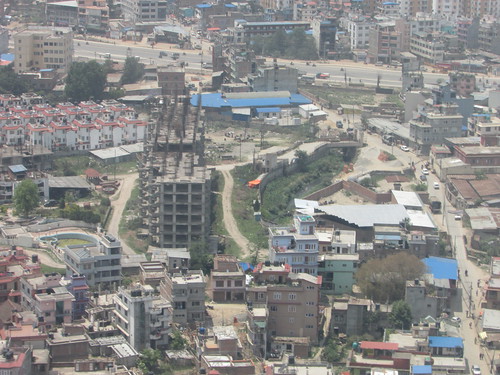
Nepal from above: Arriving in Kathmandu 11th May 2018
I found the ‘Visa on Arrival’ system confusing and eventually managed to apply using a touch-screen machine similar to an automated airport Check-in terminal but including a camera to take a passport-style image of the applicant. This machine issued a receipt confirming my application which I then presented at a payment counter with 25 U.S. Dollars. Armed with a receipt for the application, the cash receipt and my passport, I then went to the row of immigration desks marked 'Foreigners' and was officially admitted to Nepal. Of course, each of these stages involved separate queues. By the time I reached the crowded Baggage Hall, my two bags were on the belt so I was able to quickly move through the Green Channel in customs and into an Arrival Hall lined with tourist information and taxi offices. There was no sign of representatives from tour companies and I found myself on the pavement outside with cars and taxis streaming by. Seeing my bewilderment, a policeman asked, in excellent English, if he could help and he pointed out a row of representatives behind a barrier on the other side of the road. I spotted the representative from ‘&Beyond’ and, having met up, we made out way to the car park and a people carrier. He explained that security in Kathmandu was unusually tight because the Prime Minister of India, Mr. Modi, was about to arrive on a diplomatic visit to Nepal.
The main roads bristled with police security and traffic was heavy. The flags of India and Nepal were frequently displayed and we passed a couple of temporary arches of welcome. Off the main roads, shops lined both sides of the narrow streets, frequently unsurfaced, with traffic and pedestrians crammed together. The effect was a bit like Yangon, a bit like Delhi but, I suspect, essentially Nepali.
We were headed for Dwarika’s Hotel but, my guide explained, Mr. Modi was hosting a dinner at Dwarika’s in the evening (although staying at the larger Hyatt Hotel) and that we would not be able to use the front entrance. Instead, we stopped in a very narrow lane and walked up an unpromising-looking alley to a set of padlocked gates. We were admitted by a uniformed security guard, who gave me a smart salute, and ushered to an outdoor reception desk. A member of the hotel staff gave me a brief tour of the layout of the hotel whilst waiting for a ‘thumbs up’ from a colleague to indicate that my room was ready.
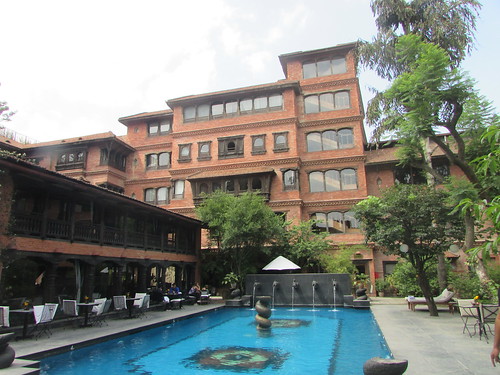
Dwarika's Hotel, Kathmandu, 11th May 2018
I was shown up to my spacious and charming room and, after a short interlude allowing a quick wash, I met my guide at the unlikely back entrance and we went on an absorbing sightseeing tour. First, we went to historic Patan Darbar Square where a number of important buildings and temples are being reconstructed, with international assistance, following the devastating 2015 earthquakes.
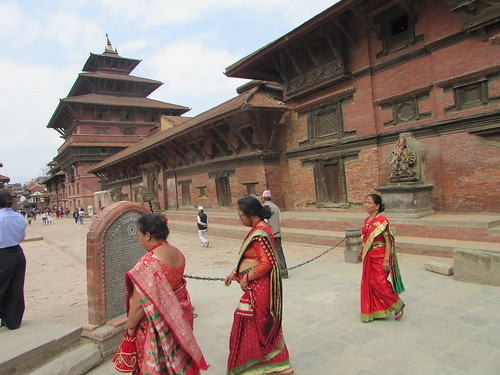 Patan, Kathmandu 11th May 2018
Patan, Kathmandu 11th May 2018
In the height of the afternoon rush hour, we made very tedious progress across the city to the Swayambhu Mahachaitva, the iconic hilltop Buddhist shrine. Although Nepal is only about 11% Buddhist and 80% Hindu, this shrine, dubbed the ‘Monkey Temple’ by ‘60s hippies who ‘discovered’ Nepal, is important to both Buddhist and Hindu. There were certainly crowds of visitors during my visit.
Another slow journey, giving further opportunities to study street life in Kathmandu, returned me to Dwarika’s (via the back gate) and my guide said he’d pick me up at 4.30 a.m. the following day. I didn’t venture out again that evening, very comfortable in my room. There was a very adequate Wi-Fi so I worked for a time and then slept very well in the large bed.
Related posts on this website
This is the first in a series of posts describing my visit to Nepal in 2018. Clicking on the 'Next report' link displays the post describing the next events. In this way, you may read about the trip in sequence.
Next report
Alternately, clicking on the 'All my Nepal reports' link displays all the posts on this trip in reverse date-of-posting order.
All my Nepal reports.
My pictures
Yangon to Kathmandu via Bangkok
Nepal from above
Kathmandu Airport
Patan, Kathmandu
Swayambhu Mahachitva Temple, Kathmandu
Kathmandu
Dwarika's Hotel, Kathmandu
All my pictures on this trip to Nepal can be found in the collection Nepal.
[Pictures linked 2-Jul-2018: Pictures added 7-Aug-2018]







 Worcester Area Rail: Great Malvern station Up platform, 28th July 2018.
Worcester Area Rail: Great Malvern station Up platform, 28th July 2018.

















































